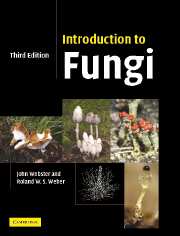Book contents
- Frontmatter
- Contents
- Preface to the first edition
- Preface to the second edition
- Preface to the third edition
- Acknowledgements
- 1 Introduction
- 2 Protozoa: Myxomycota (slime moulds)
- 3 Protozoa: Plasmodiophoromycota
- 4 Straminipila: minor fungal phyla
- 5 Straminipila: Oomycota
- 6 Chytridiomycota
- 7 Zygomycota
- 8 Ascomycota (ascomycetes)
- 9 Archiascomycetes
- 10 Hemiascomycetes
- 11 Plectomycetes
- 12 Hymenoascomycetes: Pyrenomycetes
- 13 Hymenoascomycetes: Erysiphales
- 14 Hymenoascomycetes: Pezizales (operculate discomycetes)
- 15 Hymenoascomycetes: Helotiales (inoperculate discomycetes)
- 16 Lichenized fungi (chiefly Hymenoascomycetes: Lecanorales)
- 17 Loculoascomycetes
- 18 Basidiomycota
- 19 Homobasidiomycetes
- 20 Homobasidiomycetes: gasteromycetes
- 21 Heterobasidiomycetes
- 22 Urediniomycetes: Uredinales (rust fungi)
- 23 Ustilaginomycetes: smut fungi and their allies
- 24 Basidiomycete yeasts
- 25 Anamorphic fungi (nematophagous and aquatic forms)
- References
- Index
- Plate section
21 - Heterobasidiomycetes
- Frontmatter
- Contents
- Preface to the first edition
- Preface to the second edition
- Preface to the third edition
- Acknowledgements
- 1 Introduction
- 2 Protozoa: Myxomycota (slime moulds)
- 3 Protozoa: Plasmodiophoromycota
- 4 Straminipila: minor fungal phyla
- 5 Straminipila: Oomycota
- 6 Chytridiomycota
- 7 Zygomycota
- 8 Ascomycota (ascomycetes)
- 9 Archiascomycetes
- 10 Hemiascomycetes
- 11 Plectomycetes
- 12 Hymenoascomycetes: Pyrenomycetes
- 13 Hymenoascomycetes: Erysiphales
- 14 Hymenoascomycetes: Pezizales (operculate discomycetes)
- 15 Hymenoascomycetes: Helotiales (inoperculate discomycetes)
- 16 Lichenized fungi (chiefly Hymenoascomycetes: Lecanorales)
- 17 Loculoascomycetes
- 18 Basidiomycota
- 19 Homobasidiomycetes
- 20 Homobasidiomycetes: gasteromycetes
- 21 Heterobasidiomycetes
- 22 Urediniomycetes: Uredinales (rust fungi)
- 23 Ustilaginomycetes: smut fungi and their allies
- 24 Basidiomycete yeasts
- 25 Anamorphic fungi (nematophagous and aquatic forms)
- References
- Index
- Plate section
Summary
Introduction
The class Heterobasidiomycetes is approximately synonymous with the terms ‘Phragmobasidiomycetes’ or ‘jelly fungi’ and contains fungi with the following characteristics.
1. The dolipore septum is complex, i.e. it is surrounded by a parenthesome. Parenthesomes are also found in the Homobasidiomycetes (Chapters 19 and 20), but not in the Urediniomycetes (Chapter 22) and Ustilaginomycetes (Chapter 23).
2. The basidia of Heterobasidiomycetes may be strongly lobed and often divided by transverse, oblique or longitudinal septa. Such basidia are loosely termed heterobasidia, especially if they arise directly from hyphae instead of teliospores as in most Urediniomycetes and Ustilaginomycetes. If the basidia are septate, they are also called phragmobasidia. The sterigma of the heterobasidium is unusually prominent and is often termed epibasidium (Martin, 1945). In contrast, the basidia of Homobasidiomycetes are club-shaped and always single-celled.
3. The fruit bodies of most Heterobasidiomycetes are simpler in architecture than those of Homobasidiomycetes, and the hymenium is not normally protected by a roof- or shelf-like architecture. In compensation, these simple fruit bodies are generally able to survive drying and rehydration, with fresh crops of basidiospores produced after each rehydration event. Fully hydrated basidiocarps are typically greatly swollen and gelatinous, hence the term ‘jelly fungi’ for the Heterobasidiomycetes.
4. The basidiospores of most species are capable of producing secondary spores which may be ballistoconidia, passively released conidia or yeast cells.
Species included in this class show considerable morphological diversity, and taxonomic concepts have been in a state of flux.
- Type
- Chapter
- Information
- Introduction to Fungi , pp. 593 - 608Publisher: Cambridge University PressPrint publication year: 2007



